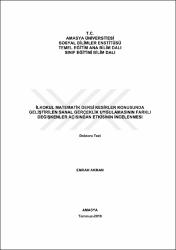| dc.contributor.advisor | Çakır, Recep | |
| dc.contributor.author | Akman, Emrah | |
| dc.date.accessioned | 2022-03-09T14:56:32Z | |
| dc.date.available | 2022-03-09T14:56:32Z | |
| dc.date.issued | 2019 | |
| dc.identifier.uri | https://tez.yok.gov.tr/UlusalTezMerkezi/TezGoster?key=vjszP7PzV0HebcjFEvDfwASmq-cdEfS4gLAtxRcK4TGxL-cWqheXtkgVZ96WmKee | |
| dc.identifier.uri | https://hdl.handle.net/20.500.12450/2001 | |
| dc.description.abstract | Bu araştırmanın amacı; ilkokul dördüncü sınıf matematik dersi kesirler konusunda senaryo tabanlı öğrenme yaklaşımına göre, öğrencilerin kesir kavramını ve kesir kavramına bağlı işlemleri içselleştirebilmesine yönelik eğitsel sanal gerçeklik uygulaması geliştirmek ve bu uygulamayı akademik başarı, öğrenci bağlılığı ve akış kuramı boyutlarıyla değerlendirmektir. Araştırmada kesirler konusunun kazanımları çerçevesinde düzenlenmiş etkinliklerin yer aldığı, toplamda dört bölümden oluşan eğitsel sanal gerçeklik uygulaması geliştirilmiş ve uygulamaya "Keşfet Kurtul" ismi verilmiştir. Keşfet Kurtul alan uzmanlarının görüşleri doğrultusunda, haftada bir ders saati kullanılabilecek şekilde tasarlanmış ve kazanımlara göre bölümlere ayırılmıştır. Araştırmada karma araştırma modeli kullanılmıştır. Çalışmanın nicel verileri matematik dersine bağlılık ölçeği, etkinlik tecrübe ölçeği ve kesirler konusuna yönelik akademik başarı testi ile toplanmıştır. Nitel veriler ise yarı yapılandırılmış görüşme formları, gözlem raporları ve öğrenci notları ile elde edilmiştir. Toplam 64 ilkokul dördüncü sınıf öğrencisi araştırmaya katılımcı olarak dahil edilmiştir. Görüşmeler etkinlik tecrübe ölçeğinden elde edilen sonuçlardan tipik durum örneklemesi ile seçilen dört öğrenci ile yapılmış ve öğrenci notları bu öğrenciler tarafından doldurulmuştur. Ayrıca araştırmacı ile birlikte üç öğretmen gözlemci olarak sürece katılmıştır. Araştırmada, deney grubunda kullanılan eğitsel sanal gerçeklik uygulaması Keşfet Kurtul ile kontrol grubunda uygulanan ve mobil uygulama ağırlıklı olan mevcut yöntemin, öğrencilerin akademik başarılarına etkileri arasında anlamlı bir farklılık olmadığı sonucu bulunmuştur. Benzer şekilde, öğrencilerin matematik dersine bağlılıkları değerlendirildiğinde, deney ve kontrol grubunda kullanılan yöntemlerin istatistiksel olarak anlamlı bir fark göstermediği sonucuna ulaşılmıştır. Etkinlik tecrübe ölçeği kullanılarak elde edilen akış deneyimi verilerine göre, deney grubunda kullanılan eğitsel sanal gerçeklik uygulaması Keşfet Kurtul'un, kontrol grubunda kullanılan ve mobil uygulama ağırlıklı olan mevcut yönteme göre istatistiksel olarak anlamlı bir şekilde daha etkili olduğu saptanmıştır. Nitel verilerden elde edilen bulgulara göre, eğitsel sanal gerçeklik uygulaması Keşfet Kurtul'un daha iyi bir akış deneyimi sağlaması için bazı bölümlerinde düzenlenmeler yapılabileceği sonucuna ulaşılmıştır. | en_US |
| dc.description.abstract | The purpose of this study; is to develop an educational virtual reality application about fractions of fourth grade and to evaluate this application with the dimensions of academic achievement, student engagement and flow theory. In the research, educational virtual reality application which consists of four parts and including activities related to fractions subject has been developed and the application is named as "Keşfet Kurtul". Keşfet Kurtul has been designed in such a way that the fractions lasting a total of 4 weeks can be used every week, according to the opinions of the field experts. Mixed research method was used in the research. The quantitative data of the research were collected with the Academic Achievement Test developed by the researcher for fractions, Student Engagement in Mathematics Scale and Flow State Scale. Qualitative data of the study were obtained through semi-structured interview forms, observation reports and student notes. A total of 64 fourth grade students were included in the study. Interviews were conducted with 4 students selected by typical case sampling from the results obtained from the flow state scale and notes were filled out by these students. In addition, the researcher and 3 teachers participated as observers to the study. According to the results of the research it was found that the educational virtual reality application Keşfet Kurtul used in the experimental group, and the current method applied in the control group, had the same effect on the academic achievement of students. Similarly, when the students' engagement to mathematics was evaluated, it was concluded that the methods used in the experimental and control groups did not show a statistically significant difference. When the flow experience data obtained using the Flow State Scale were analyzed, it was found that the educational virtual reality application Keşfet Kurtul used in the experimental group was more effective than the current method used in the control group. This result is consistent with the findings obtained from the qualitative data of the study. According to the findings obtained from qualitative data, it has been concluded that in some parts of the educational virtual reality application Keşfet Kurtul can be arranged to provide a better flow experience. | en_US |
| dc.language.iso | tur | en_US |
| dc.publisher | Amasya Üniversitesi | en_US |
| dc.rights | info:eu-repo/semantics/openAccess | en_US |
| dc.subject | Eğitim ve Öğretim | en_US |
| dc.subject | Education and Training | en_US |
| dc.subject | Akış deneyimi | en_US |
| dc.subject | Flow experience | en_US |
| dc.subject | Eğitsel oyunlar | en_US |
| dc.subject | Educational games | en_US |
| dc.subject | Matematik | en_US |
| dc.subject | Mathematics | en_US |
| dc.subject | Matematik dersi | en_US |
| dc.subject | Mathematics lesson | en_US |
| dc.subject | Matematik eğitimi | en_US |
| dc.subject | Mathematics education | en_US |
| dc.subject | Mobil uygulama | en_US |
| dc.subject | Mobile application | en_US |
| dc.subject | Sanal gerçeklik | en_US |
| dc.subject | Virtual reality | en_US |
| dc.subject | Senaryo tabanlı öğrenme | en_US |
| dc.subject | Cenario based-learning | en_US |
| dc.subject | İlkokullar | en_US |
| dc.subject | Primary schools Onaylandı | en_US |
| dc.title | İlkokul matematik dersi kesirler konusunda geliştirilen sanal gerçeklik uygulamasının farklı değişkenler açısından etkisinin incelenmesi | en_US |
| dc.title.alternative | The investigation of the effects of a virtual reality application developed for fractions in the mathematics lessons of elementary school considering some different variables | en_US |
| dc.type | doctoralThesis | en_US |
| dc.department | Enstitüler, Sosyal Bilimler Enstitüsü, Temel Eğitim Ana Bilim Dalı | en_US |
| dc.identifier.startpage | 1 | en_US |
| dc.identifier.endpage | 184 | en_US |
| dc.relation.publicationcategory | Tez | en_US |
| dc.identifier.yoktezid | 587141 | en_US |
| dc.institutionauthor | Akman, Emrah | |


















